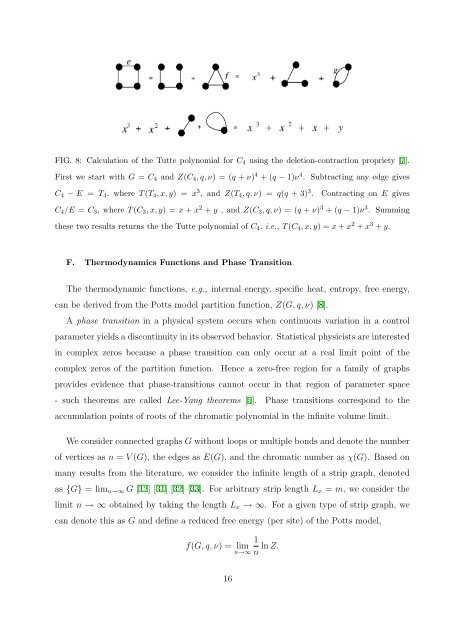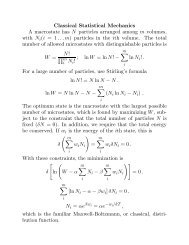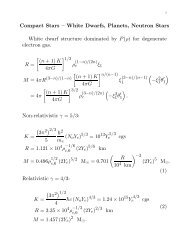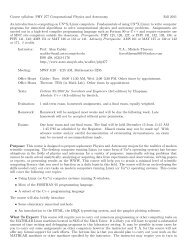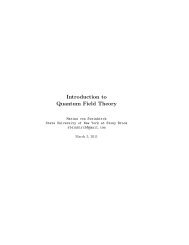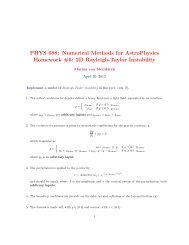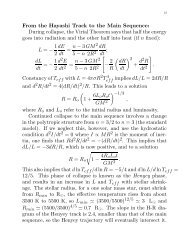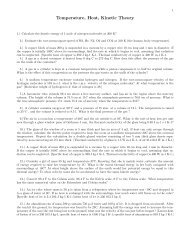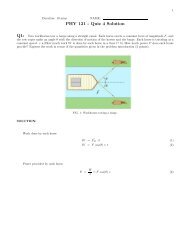On the study of the Potts model, Tutte and Chromatic Polynomials ...
On the study of the Potts model, Tutte and Chromatic Polynomials ...
On the study of the Potts model, Tutte and Chromatic Polynomials ...
Create successful ePaper yourself
Turn your PDF publications into a flip-book with our unique Google optimized e-Paper software.
FIG. 8: Calculation <strong>of</strong> <strong>the</strong> <strong>Tutte</strong> polynomial for C 4 using <strong>the</strong> deletion-contraction propriety [7].<br />
First we start with G = C 4 <strong>and</strong> Z(C 4 , q, ν) = (q + ν) 4 + (q − 1)ν 4 . Subtracting any edge gives<br />
C 4 − E = T 4 , where T (T 4 , x, y) = x 3 , <strong>and</strong> Z(T 4 , q, ν) = q(q + 3) 3 .<br />
Contracting on E gives<br />
C 4 /E = C 3 , where T (C 3 , x, y) = x + x 2 + y , <strong>and</strong> Z(C 3 , q, ν) = (q + ν) 3 + (q − 1)ν 3 . Summing<br />
<strong>the</strong>se two results returns <strong>the</strong> <strong>the</strong> <strong>Tutte</strong> polynomial <strong>of</strong> C 4 , i.e., T (C 4 , x, y) = x + x 2 + x 3 + y.<br />
F. Thermodynamics Functions <strong>and</strong> Phase Transition<br />
The <strong>the</strong>rmodynamic functions, e.g., internal energy, specific heat, entropy, free energy,<br />
can be derived from <strong>the</strong> <strong>Potts</strong> <strong>model</strong> partition function, Z(G, q, ν) [8].<br />
A phase transition in a physical system occurs when continuous variation in a control<br />
parameter yields a discontinuity in its observed behavior. Statistical physicists are interested<br />
in complex zeros because a phase transition can only occur at a real limit point <strong>of</strong> <strong>the</strong><br />
complex zeros <strong>of</strong> <strong>the</strong> partition function.<br />
Hence a zero-free region for a family <strong>of</strong> graphs<br />
provides evidence that phase-transitions cannot occur in that region <strong>of</strong> parameter space<br />
- such <strong>the</strong>orems are called Lee-Yang <strong>the</strong>orems [5]. Phase transitions correspond to <strong>the</strong><br />
accumulation points <strong>of</strong> roots <strong>of</strong> <strong>the</strong> chromatic polynomial in <strong>the</strong> infinite volume limit.<br />
We consider connected graphs G without loops or multiple bonds <strong>and</strong> denote <strong>the</strong> number<br />
<strong>of</strong> vertices as n = V (G), <strong>the</strong> edges as E(G), <strong>and</strong> <strong>the</strong> chromatic number as χ(G). Based on<br />
many results from <strong>the</strong> literature, we consider <strong>the</strong> infinite length <strong>of</strong> a strip graph, denoted<br />
as {G} = lim n→∞ G [12] [31] [32] [33]. For arbitrary strip length L x = m, we consider <strong>the</strong><br />
limit n → ∞ obtained by taking <strong>the</strong> length L x → ∞. For a given type <strong>of</strong> strip graph, we<br />
can denote this as G <strong>and</strong> define a reduced free energy (per site) <strong>of</strong> <strong>the</strong> <strong>Potts</strong> <strong>model</strong>,<br />
1<br />
f(G, q, ν) = lim ln Z.<br />
n→∞ n<br />
16


